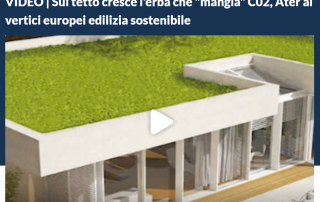About the project.
LIFE CAPT-TILE: transforming Urban Spaces with Green Technology
The project aims to revolutionize the adoption of green roofs and vertical gardens by addressing economic and maintenance barriers that limit their widespread use.
Our goal is to develop affordable, easy-to-install, and low-maintenance solutions for green architectural surfaces, making them accessible to everyone. The main innovation of the LIFE CAPT-TILE project lies in new clay tiles capable of hosting a layer of “artificial soil” to support plant growth.
This modular and lightweight system not only simplifies installation and maintenance but also allows CO2 absorption from the atmosphere, contributing to the fight against climate change.
Objectives.
Benefits.
Impacts.
The LIFE CAPT-TILE project is expected to generate significant impacts:
01. Societal
- Improved Quality of Life: Green spaces offer recreational opportunities and enhance well-being.
- Educational Opportunities: Demonstration sites serve as educational tools on sustainable development.
- Community Engagement: Encourages community involvement in greening initiatives, fostering pride among residents.
02. Environmental
- Cooling Urban Areas: Increased vegetation on roofs and facades helps reduce the urban heat island effect.
- Enhanced Biodiversity: Green roofs and facades provide habitats for plants, insects, and birds.
- Improved Air Quality: Plants absorb CO2 and pollutants, resulting in cleaner urban air.
03. Economic
- Lower Energy Costs: Improved insulation leads to reduced energy consumption for heating and cooling.
- Increased Property Value: Attractive green roofs and facades can increase property values.
- Job Creation: New opportunities in construction, horticulture, and environmental services.
Case Studies.
The LIFE CAPT-TILE project includes two real-case installations to demonstrate the feasibility and benefits of the CAPT-TILE system.


News & Events.
BGTeC presents the LIFE CAPTILE project at Expo Osaka 2025
We are pleased to announce that our partner BGTeC [...]
Month 12 General Assembly and Monitoring Visit Successfully Concluded
On 7–8 May, the General Assembly one year after [...]
ATER Padova’s Green Roofs Featured in the Media
We are thrilled to share two articles highlighting the [...]
LIFE CAPT-TILE Project Participates in Webinar “Clay Tile Roof Coverings”
On Tuesday, November 12, 2024, the LIFE CAPT-TILE project [...]
LIFE CAPT-TILE Project News: M5 Plenary Meeting in Possagno
On October 23-24, 2024, the LIFE CAPT-TILE project consortium [...]
Successful First Kick Off Meeting for the Life Capt-Tile Project
On July 31, 2024, the Life Capt-Tile project held [...]
Partners.

Role: Coordinator
Description: ICP is the project leader, responsible for overall management and coordination of activities. They provide expertise in terracotta tile manufacturing and contribute to the development of the prototype tiles for green surfaces.

Role: Project Partner
Description: SMAC contributes to the technological development of the project, providing innovative solutions for tile surface treatment. Their contribution is essential to ensuring the functionality and durability of tiles that support vegetation growth.

Università Politecnica delle Marche (UNIVPM)
Role: Project Partner
Description: The university plays a crucial role in scientific research and development. It conducts in-depth studies on materials and tile design, testing the system’s effectiveness in capturing CO2 and promoting biodiversity.

Consiglio Nazionale delle Ricerche (CNR)
Role: Project Partner
Description: CNR contributes with its expertise in scientific and technological research, focusing on the environmental aspects of the project. It is responsible for monitoring and evaluating the environmental impact of the green surfaces developed..

Bergamo Tecnologie SPZOO (BGTEC)
Role: Project Partner
Description: BGTEC is responsible for the design and development of the technologies needed for the industrial production of the innovative tiles. They handle the pre-industrial scale-up of the system and its practical implementation.

Azienda Territoriale Edilizia Residenziale della Provincia di Padova (ATER)
Role: Project Partner
Description: ATER contributes to the project demonstration by installing the tiles in its residential buildings. Their role is crucial for testing the system’s applicability in residential construction and social housing contexts







Get Social!